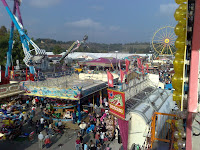The current issue interactions (http://interactions.acm.org) features some interesting articles – at least scanning through it and reading some of them prolonged my breakfast today considerably 😉
 The cover story gives an already in its title a very interesting definition of tangible interaction (Tangible Interaction = Form + Computing) [1]. Their view is very much from a design perspective, but provides a good introduction to the topic.
The cover story gives an already in its title a very interesting definition of tangible interaction (Tangible Interaction = Form + Computing) [1]. Their view is very much from a design perspective, but provides a good introduction to the topic.
The article by Jay Chaeyong Yi on a success story from Korea is a very good case study of how to apply UI research [2]. It shows (1) a comprehensive example of user driven research and (2) the value and importance it contributes to a product/service. Even though the article describes a project from 2005 I find the topic of messaging on phone still exciting and the example of IM vs. SMS can still tell a lot. Personally I am really interested in where messaging on the phone goes – perhaps there is some time next week in Tampere to discuss this.
Not central on user interfaces but still quite interesting is the article on operationalizing brands with Web 2.0 technologies [3]. The example of eBags.com shows interestingly what is currently possible. Thinking and imagine a bit further and considering the opportunities that arise from the web/internet of things (e.g. where you know from the bag how it is used and can communicate this) some real change will be ahead. And some companies are slowly getting to the point of bringing first products that go into this direction (Ali pointed me to http://greengoose.com).
After setting up some IKEA furniture with my daughter (model BENNO as bookshelf for paper backs and not for CD/DVDs) I found Don Norman’s article where he discusses the issue consuming vs. producing or spectator vs. creator quite interesting [4].
[1] Baskinger, M. and Gross, M. 2010. Tangible interaction = form + computing. interactions 17, 1 (Jan. 2010), 6-11. DOI= http://doi.acm.org/10.1145/1649475.1649477
[2] Yi, J. C. 2010. User-research-driven mobile user interface innovation: a success story from Seoul. interactions 17, 1 (Jan. 2010), 48-51. DOI= http://doi.acm.org/10.1145/1649475.1649487
[3] Yohn, D. L. 2010. Operationalizing brands with new technologies. interactions 17, 1 (Jan. 2010), 24-27. DOI= http://doi.acm.org/10.1145/1649475.1649481
[4] Norman, D. A. 2010. The transmedia design challenge: technology that is pleasurable and satisfying. interactions 17, 1 (Jan. 2010), 12-15. DOI= http://doi.acm.org/10.1145/1649475.1649478



















 Christofer Lueg
Christofer Lueg

